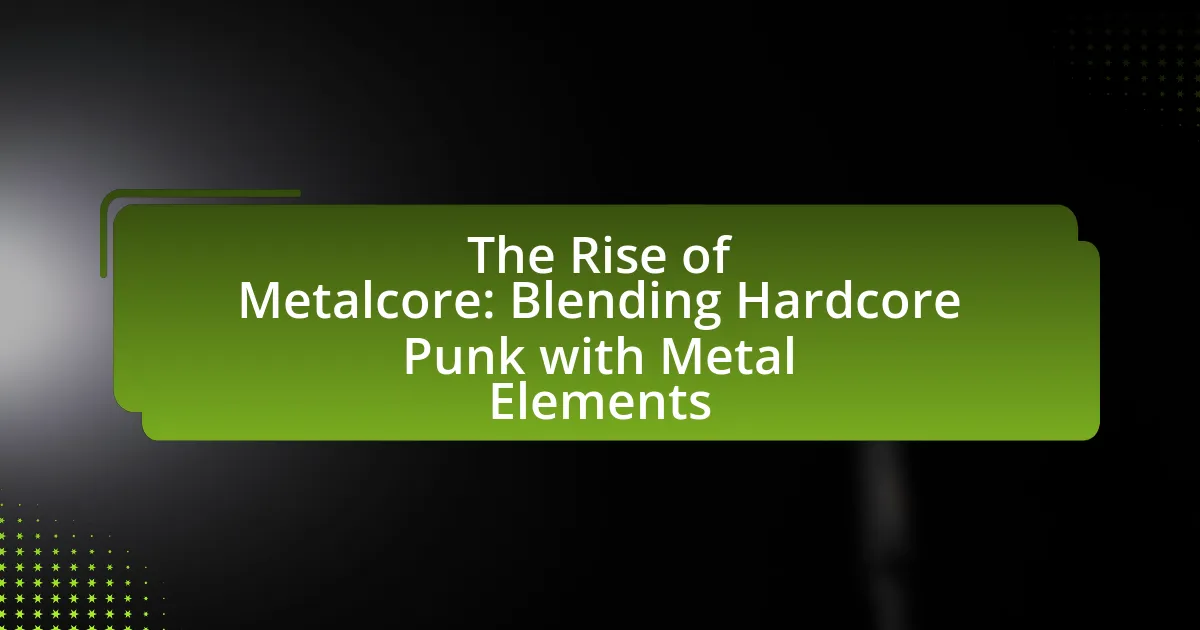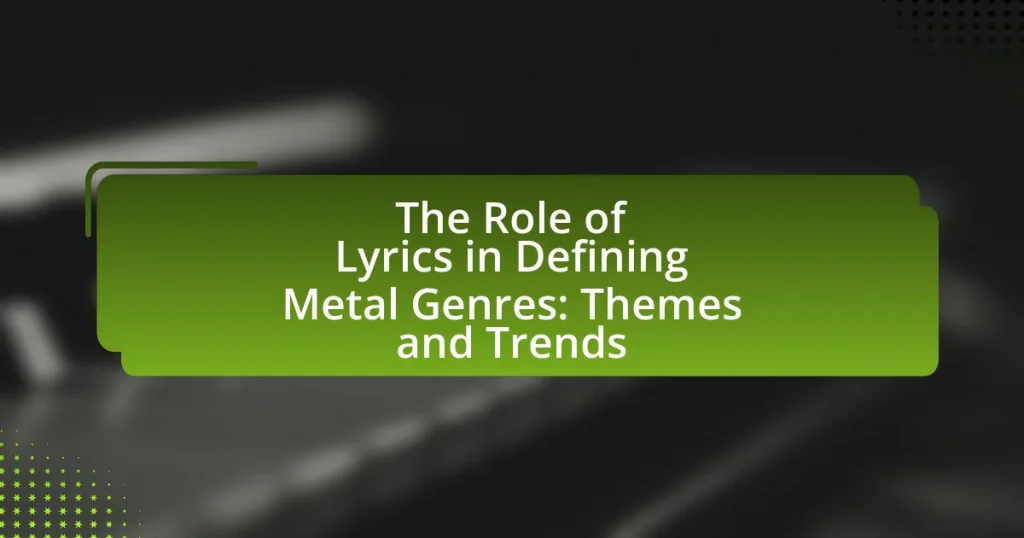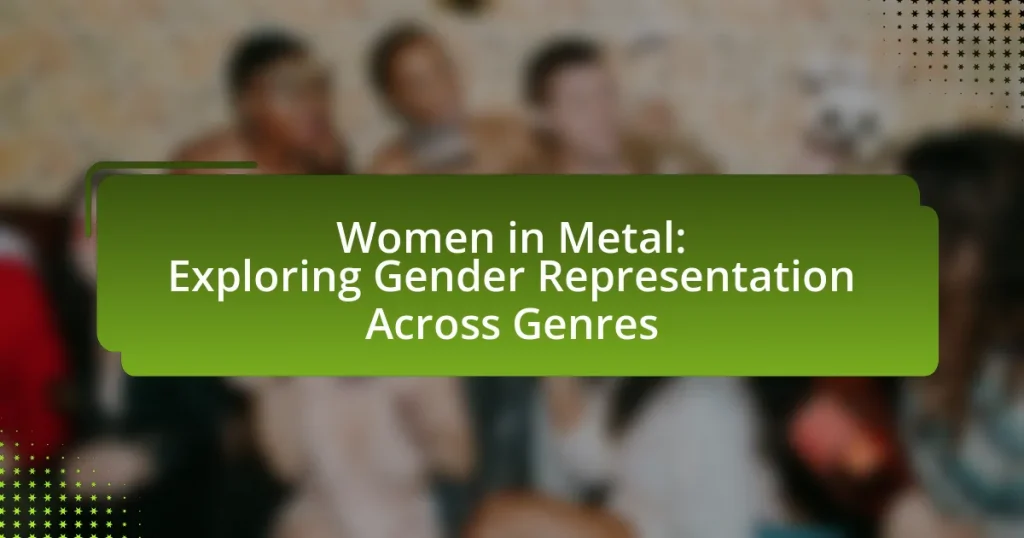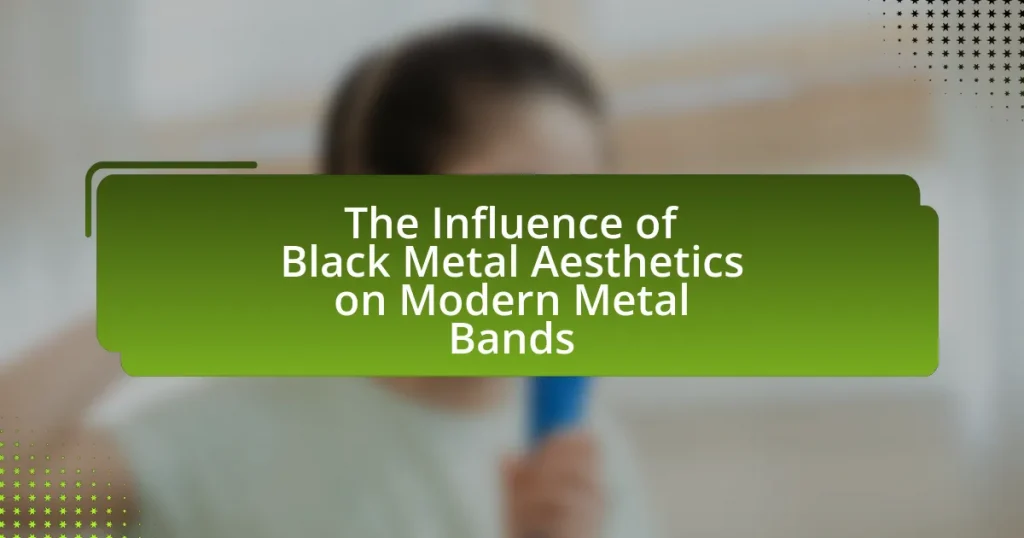Metalcore is a musical genre that fuses elements of hardcore punk and heavy metal, characterized by aggressive guitar riffs, breakdowns, and a combination of harsh and clean vocals. Emerging in the late 1980s and early 1990s, it gained popularity in the early 2000s through bands like Killswitch Engage and As I Lay Dying, who introduced melodic elements to the genre. The article explores the defining characteristics of both hardcore punk and metal, the historical context that contributed to the rise of Metalcore, key bands and albums that shaped its evolution, and current trends influencing its future direction. Additionally, it addresses the challenges faced by Metalcore in today’s music industry and offers insights on how listeners can discover and enjoy this dynamic genre.
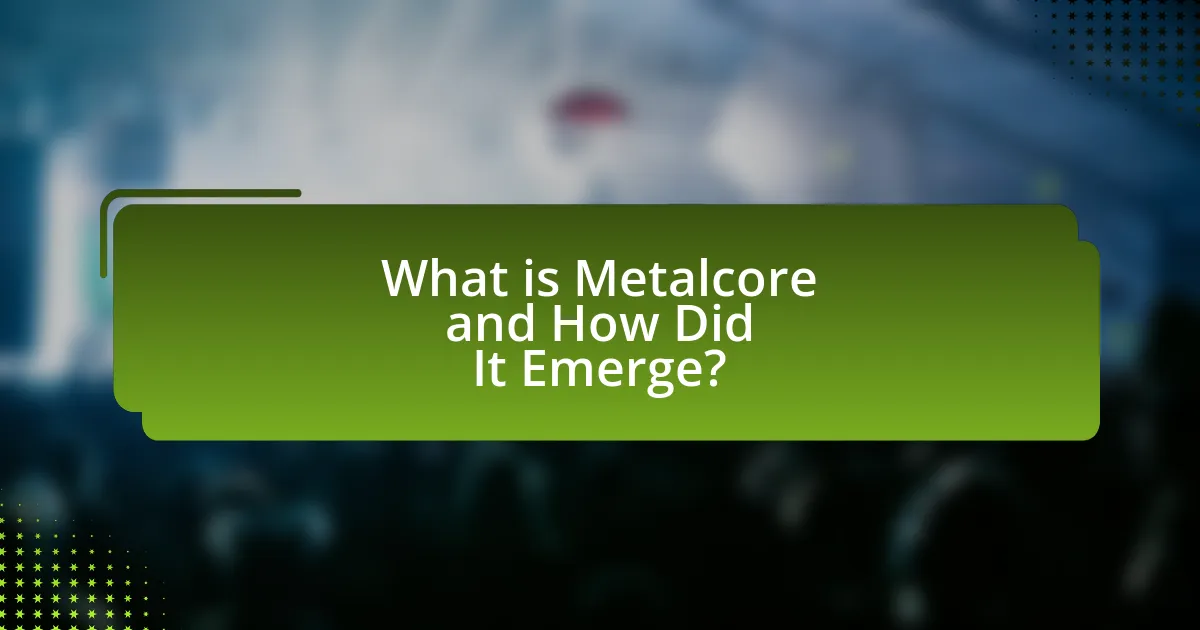
What is Metalcore and How Did It Emerge?
Metalcore is a fusion genre that combines elements of hardcore punk and heavy metal, characterized by aggressive guitar riffs, breakdowns, and a mix of harsh and clean vocals. It emerged in the late 1980s and early 1990s, with bands like Earth Crisis and Converge laying the groundwork by integrating metal influences into their hardcore sound. The genre gained significant popularity in the early 2000s, propelled by bands such as Killswitch Engage and As I Lay Dying, who brought a more melodic approach to the style. This evolution was marked by the incorporation of metalcore’s signature breakdowns and dual vocal styles, which became defining features of the genre.
How does Metalcore blend Hardcore Punk and Metal elements?
Metalcore blends Hardcore Punk and Metal elements by combining the aggressive, fast-paced rhythms and vocal styles of Hardcore Punk with the complex guitar riffs, breakdowns, and solos characteristic of Metal. This fusion is evident in the use of heavy distortion, syncopated drumming, and a mix of screaming and melodic vocals, which creates a dynamic sound that appeals to fans of both genres. Historically, bands like Earth Crisis and Converge laid the groundwork for this blend in the early 1990s, while later groups such as Killswitch Engage and As I Lay Dying further popularized the style, showcasing the seamless integration of Hardcore’s raw energy with Metal’s technical proficiency.
What are the defining characteristics of Hardcore Punk?
Hardcore Punk is characterized by its fast tempos, aggressive guitar riffs, and raw, shouted vocals. This genre emerged in the late 1970s and is known for its DIY ethic, often rejecting mainstream music conventions. The lyrical content typically addresses social and political issues, reflecting a sense of rebellion and discontent. Bands like Black Flag and Minor Threat exemplify these traits, with their music often featuring short, intense songs that emphasize energy and urgency. The genre’s influence can be seen in the development of metalcore, which incorporates elements of hardcore punk while blending in metal instrumentation and structures.
What are the key features of Metal music that influence Metalcore?
The key features of Metal music that influence Metalcore include heavy guitar riffs, aggressive drumming, and a focus on both melodic and harsh vocal styles. Heavy guitar riffs, characterized by distortion and complex chord progressions, provide the foundational sound that Metalcore builds upon. Aggressive drumming, often utilizing double bass techniques and fast tempos, enhances the intensity of the music, aligning with the energetic nature of Hardcore Punk. Additionally, Metalcore incorporates a dual vocal approach, combining melodic singing with growled or screamed vocals, which reflects the emotional range and aggression found in both Metal and Hardcore Punk genres. These elements collectively create a sound that is both heavy and dynamic, defining the Metalcore genre.
What historical events contributed to the rise of Metalcore?
The rise of Metalcore was significantly influenced by the emergence of Hardcore Punk in the late 1970s and early 1980s, which laid the groundwork for the genre’s fusion with metal elements. The Hardcore Punk scene, characterized by its aggressive sound and DIY ethic, inspired bands to experiment with heavier instrumentation and complex song structures. In the 1990s, the popularity of bands like Earth Crisis and Converge further integrated metal influences, leading to the development of Metalcore as a distinct genre. Additionally, the advent of the internet in the late 1990s and early 2000s facilitated the spread of Metalcore, allowing bands to reach wider audiences and share their music more easily. This combination of Hardcore Punk roots, metal integration, and digital accessibility solidified Metalcore’s place in the music landscape.
How did the punk rock scene influence the development of Metalcore?
The punk rock scene significantly influenced the development of Metalcore by introducing aggressive musical styles, DIY ethics, and a focus on social and political themes. Punk’s fast tempos, raw sound, and rebellious attitude laid the groundwork for Metalcore’s fusion of hardcore punk and heavy metal elements. Bands like Minor Threat and Black Flag exemplified the hardcore punk ethos, which emphasized intensity and authenticity, traits that Metalcore bands adopted. Additionally, the punk rock scene’s emphasis on independent labels and grassroots promotion inspired Metalcore artists to pursue similar paths, leading to the genre’s growth in the underground music scene during the late 1980s and early 1990s.
What role did the 1990s music scene play in shaping Metalcore?
The 1990s music scene was pivotal in shaping Metalcore by merging elements of hardcore punk and heavy metal. This decade saw the rise of influential bands such as Earth Crisis and Converge, which incorporated aggressive guitar riffs, breakdowns, and intense vocals characteristic of both genres. The emergence of labels like Victory Records and Trustkill Records facilitated the distribution of Metalcore, allowing bands to reach wider audiences. Additionally, the DIY ethic prevalent in the punk scene encouraged a grassroots movement that fostered the growth of Metalcore bands, leading to the genre’s establishment in the underground music community.
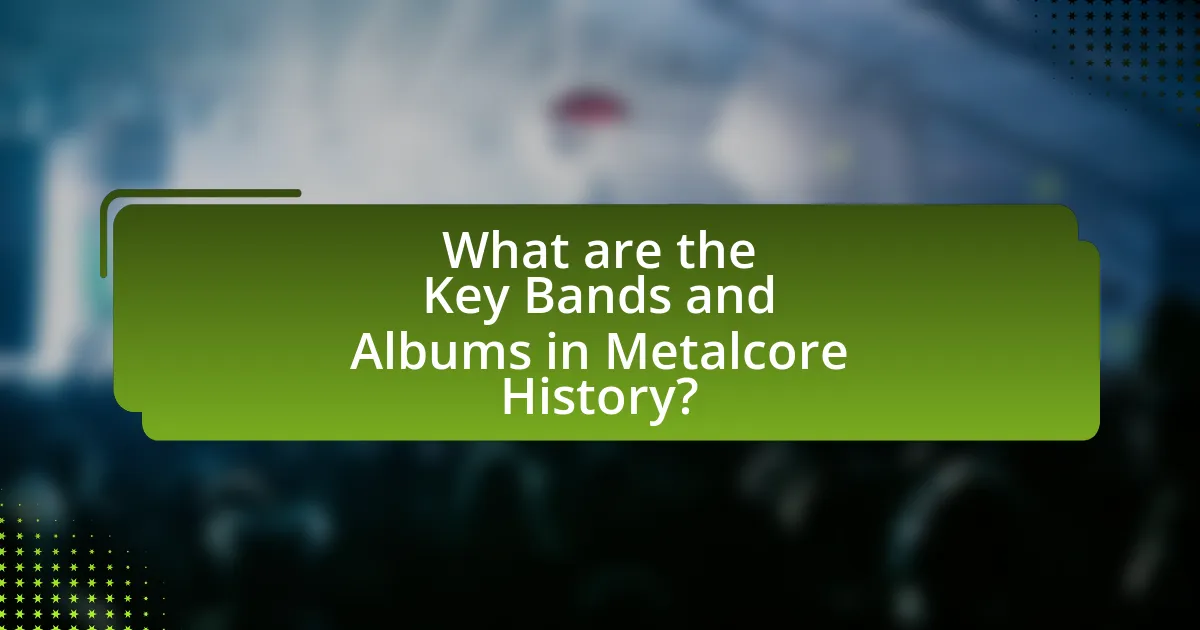
What are the Key Bands and Albums in Metalcore History?
Key bands in metalcore history include Killswitch Engage, As I Lay Dying, and Parkway Drive, while significant albums are “Alive or Just Breathing” by Killswitch Engage, “Frail Words Collapse” by As I Lay Dying, and “Horizons” by Parkway Drive. Killswitch Engage’s “Alive or Just Breathing,” released in 2002, is often credited with popularizing the genre, showcasing a blend of melodic elements and aggressive riffs. As I Lay Dying’s “Frail Words Collapse,” released in 2003, further defined the sound with its intricate guitar work and powerful vocals. Parkway Drive’s “Horizons,” released in 2007, solidified their status in the scene with its heavy breakdowns and anthemic choruses. These bands and albums have played pivotal roles in shaping metalcore’s evolution and mainstream acceptance.
Which bands are considered pioneers of the Metalcore genre?
The bands considered pioneers of the Metalcore genre include Earth Crisis, Converge, and Hatebreed. Earth Crisis, active since the early 1990s, is known for integrating hardcore punk with metal elements, particularly through their album “Firestorm.” Converge, also from the 1990s, is recognized for their complex song structures and aggressive sound, exemplified in their album “Jane Doe.” Hatebreed, emerging in the mid-1990s, further popularized the genre with their blend of hardcore and metal, particularly with their album “Satisfaction Is the Death of Desire.” These bands laid the groundwork for Metalcore, influencing countless artists and shaping the genre’s evolution.
What impact did bands like Earth Crisis and Converge have on Metalcore?
Bands like Earth Crisis and Converge significantly shaped the Metalcore genre by integrating elements of hardcore punk with metal, establishing a heavier and more aggressive sound. Earth Crisis introduced themes of veganism and environmentalism, influencing the lyrical content and ethos of the genre, while Converge’s complex song structures and chaotic energy pushed the boundaries of musicality within Metalcore. Their contributions helped define the genre’s identity in the 1990s, leading to a broader acceptance and evolution of Metalcore as a distinct musical style.
How did the sound of Killswitch Engage and As I Lay Dying define the genre?
Killswitch Engage and As I Lay Dying significantly defined the metalcore genre through their innovative fusion of melodic elements with aggressive hardcore punk and metal influences. Killswitch Engage’s incorporation of clean and harsh vocals, alongside intricate guitar riffs and breakdowns, set a standard for melodic metalcore, exemplified in their album “Alive or Just Breathing,” which showcased emotional depth and technical proficiency. Similarly, As I Lay Dying’s sound, characterized by relentless drumming and a blend of melodic and aggressive guitar work, particularly in their album “Frail Words Collapse,” emphasized the genre’s intensity while maintaining melodic hooks. Both bands contributed to the genre’s evolution by popularizing a sound that balanced aggression with melody, influencing countless bands and solidifying metalcore’s place in the broader metal landscape.
What are some landmark albums that shaped Metalcore?
Some landmark albums that shaped Metalcore include “Count Your Blessings” by Bring Me the Horizon, “The Silent Circus” by Between the Buried and Me, and “Jane Doe” by Converge. “Count Your Blessings,” released in 2006, introduced a heavier sound that influenced the genre’s direction. “The Silent Circus,” released in 2003, showcased complex song structures and technical musicianship, setting a standard for future Metalcore bands. “Jane Doe,” released in 2001, is often cited for its emotional intensity and innovative blend of hardcore and metal elements, solidifying its status as a pivotal album in the Metalcore scene.
Which albums are essential listening for understanding Metalcore’s evolution?
Essential albums for understanding Metalcore’s evolution include “Count Your Blessings” by Bring Me the Horizon, “The Silent Circus” by Between the Buried and Me, and “Jane Doe” by Converge. “Count Your Blessings,” released in 2006, showcases the early blend of metal and hardcore elements that define the genre. “The Silent Circus,” released in 2003, highlights progressive structures and complex musicianship, influencing many subsequent bands. “Jane Doe,” released in 2001, is a seminal work that pushed the boundaries of Metalcore with its emotional intensity and innovative sound. These albums collectively illustrate the genre’s development from its hardcore punk roots to a more diverse and intricate musical style.
How did these albums influence subsequent Metalcore bands?
These albums significantly influenced subsequent Metalcore bands by establishing a template that combined aggressive instrumentation with melodic elements and emotional lyrics. For instance, the incorporation of breakdowns and dual vocal styles became a hallmark of the genre, as seen in albums like “The Silent Circus” by Between the Buried and Me and “Count Your Blessings” by Bring Me the Horizon. These elements not only shaped the sound of later bands but also set a standard for lyrical themes that often explore personal struggles and societal issues. The impact is evident in the success of bands such as Architects and Parkway Drive, which adopted and evolved these foundational characteristics, further solidifying Metalcore’s place in the broader metal landscape.
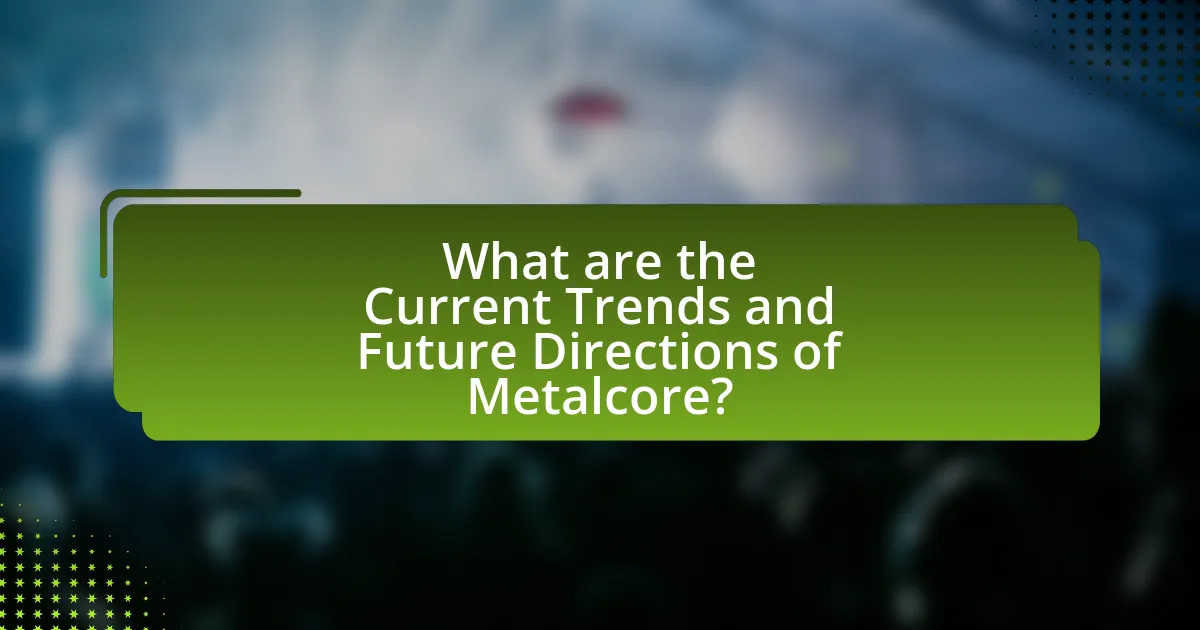
What are the Current Trends and Future Directions of Metalcore?
Current trends in metalcore include the integration of diverse musical styles, such as electronic elements and pop influences, which enhance the genre’s accessibility and appeal. Bands like Bring Me the Horizon and Architects exemplify this trend by incorporating melodic hooks and atmospheric soundscapes, attracting a broader audience. Future directions of metalcore are likely to focus on further genre fusion, with artists experimenting with hip-hop and R&B influences, as seen in the works of Spiritbox and Lorna Shore. This evolution reflects a growing trend towards innovation and collaboration within the metalcore scene, aiming to push the boundaries of traditional sound while maintaining the genre’s core intensity and emotional depth.
How has Metalcore evolved in the 21st century?
Metalcore has evolved significantly in the 21st century by incorporating diverse musical influences and expanding its thematic content. Initially rooted in the fusion of hardcore punk and metal, the genre has seen the integration of elements from genres such as post-rock, electronic music, and even pop, leading to a broader appeal. Bands like Bring Me the Horizon and Architects have exemplified this evolution, experimenting with melodic structures and electronic production techniques, which has contributed to the genre’s mainstream success. Additionally, the lyrical themes have diversified, addressing personal struggles, mental health, and social issues, reflecting a shift in the audience’s expectations and experiences. This evolution is evidenced by the increased presence of metalcore bands in major music festivals and charts, indicating a growing acceptance and popularity of the genre in contemporary music culture.
What new subgenres or styles have emerged within Metalcore?
New subgenres and styles that have emerged within Metalcore include Deathcore, which combines elements of death metal with Metalcore, and Melodic Metalcore, characterized by its emphasis on melody and clean vocals. Additionally, the rise of Post-Hardcore has influenced Metalcore, incorporating experimental sounds and diverse vocal styles. These developments reflect the genre’s evolution and its ability to integrate various musical influences, as seen in bands like Bring Me the Horizon and Architects, who have successfully blended these elements into their music.
How are modern bands incorporating diverse influences into Metalcore?
Modern bands are incorporating diverse influences into Metalcore by blending genres such as hip-hop, electronic music, and pop elements into their sound. This fusion is evident in the use of varied vocal styles, including rapping and melodic singing, which expands the emotional range of the music. For instance, bands like Bring Me the Horizon and Spiritbox have integrated electronic beats and atmospheric soundscapes, showcasing a departure from traditional Metalcore’s straightforward aggression. Additionally, the incorporation of world music elements, such as Middle Eastern scales or Latin rhythms, has been observed in tracks by bands like The Devil Wears Prada, further diversifying the genre. This trend reflects a broader cultural shift within the music industry, where genre boundaries are increasingly blurred, allowing for innovative and eclectic musical expressions.
What challenges does the Metalcore genre face today?
The Metalcore genre faces significant challenges today, primarily due to market saturation and evolving musical tastes. As the genre has gained popularity, numerous bands have emerged, leading to a crowded landscape that makes it difficult for new acts to stand out. Additionally, the rise of streaming platforms has shifted listener preferences towards more diverse genres, often sidelining Metalcore in favor of pop and hip-hop influences. According to a 2022 report by the International Federation of the Phonographic Industry, genres like pop and hip-hop accounted for over 60% of global music consumption, highlighting the competitive disadvantage Metalcore faces in attracting mainstream attention.
How is the changing music industry impacting Metalcore bands?
The changing music industry is significantly impacting Metalcore bands by altering their revenue streams and promotional strategies. With the decline of physical album sales and the rise of streaming platforms, Metalcore bands are increasingly reliant on live performances and merchandise sales for income. According to a 2021 report by the International Federation of the Phonographic Industry, global recorded music revenues grew by 7.4%, driven primarily by streaming, which has reshaped how bands engage with their audiences. Additionally, social media platforms have become essential for Metalcore bands to build their fanbase and promote their music, allowing for direct interaction and marketing without traditional label support. This shift has led to a more DIY approach, where bands must be proactive in their branding and outreach to remain competitive in a rapidly evolving landscape.
What role does social media play in the promotion of Metalcore music?
Social media plays a crucial role in the promotion of Metalcore music by providing a platform for artists to connect directly with fans and share their music. This direct engagement allows Metalcore bands to build a dedicated following, as evidenced by the significant presence of bands like Architects and Bring Me The Horizon on platforms such as Instagram and Twitter, where they interact with fans and promote new releases. Additionally, social media facilitates the rapid dissemination of music videos, live performances, and announcements, which can lead to viral trends and increased visibility. For instance, the use of TikTok has enabled songs to gain popularity quickly, with tracks from Metalcore bands often featured in user-generated content, further amplifying their reach.
What are some tips for exploring and enjoying Metalcore music?
To explore and enjoy Metalcore music, start by listening to foundational bands such as Killswitch Engage, As I Lay Dying, and Parkway Drive, as they exemplify the genre’s blend of hardcore punk and metal elements. Engaging with live performances enhances the experience, as Metalcore is known for its energetic shows that often feature mosh pits and crowd interaction. Additionally, exploring subgenres like melodic Metalcore or metalcore with electronic influences can provide a broader understanding of the genre’s diversity. Familiarizing yourself with the lyrical themes, which often address personal struggles and social issues, can deepen your appreciation. Finally, joining online communities or forums dedicated to Metalcore can connect you with other fans, offering recommendations and insights into new releases and underground bands.
How can listeners discover new Metalcore bands and albums?
Listeners can discover new Metalcore bands and albums through various platforms and methods. Streaming services like Spotify and Apple Music offer curated playlists specifically for Metalcore, featuring both established and emerging artists. Additionally, social media platforms such as Instagram and TikTok allow fans to follow bands and discover new music through recommendations and viral trends. Music forums and websites like Metal Injection and Lambgoat provide reviews and news about upcoming releases, helping listeners stay informed about new bands. Furthermore, attending live shows and festivals dedicated to Metalcore can expose fans to new talent and albums directly.
What are the best live shows or festivals to experience Metalcore?
The best live shows and festivals to experience Metalcore include the annual “Vans Warped Tour,” known for featuring a wide array of Metalcore bands, and “Download Festival,” which consistently showcases top Metalcore acts alongside other genres. Additionally, “Impericon Festival” is renowned for its focus on Metalcore and related subgenres, attracting fans from across Europe. These events are significant as they provide a platform for both established and emerging Metalcore bands, allowing fans to experience the genre’s energy and community firsthand.
